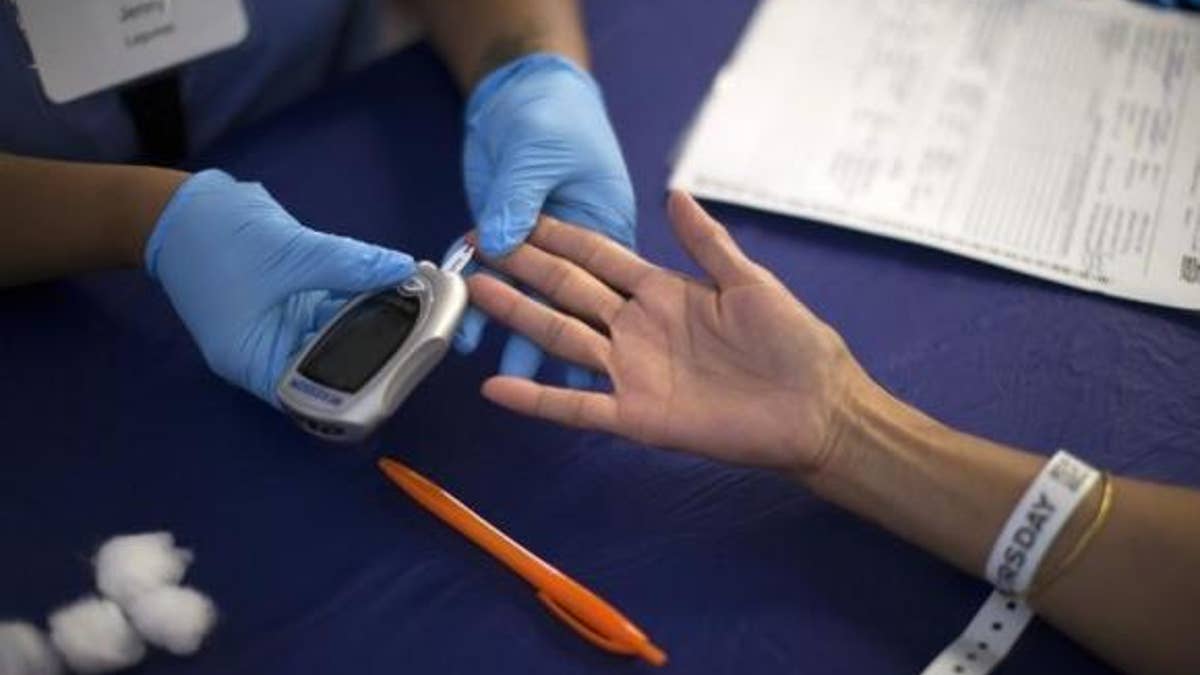
Sept. 11, 2014: A person receives a test for diabetes during Care Harbor LA free medical clinic in Los Angeles, California. (Reuters)
For six weeks seven-year-old Bethan Westcott-Storer was feeling listless and losing weight, worrying parents Lizzie and Dean. Now aged nine, she's the picture of health, having been diagnosed with type 1 diabetes in November 2014, since when she's been treating herself via an omnipod pump that delivers insulin via a cannula under her skin.
"I felt very weak and tired all the time, and if my friends in the playground said 'do you want to play It?' or something, I'd just feel like 'ohh, not really," Bethan told Reuters during a check-up at the University of Exeter Medical School.
According to her mother, "we noticed that she'd become quite thin, she'd lost a lot of weight, but she didn't have all of the signs that other children normally have with type 1 - she didn't have the excess thirst and urinating. Just lost a lot of weight, so she's been diagnosed for 15 months now."
Exeter scientists have revealed that children diagnosed before the age of seven develop a more aggressive form of the disease than that seen in teenagers. Their research could open up new, differing, treatments for both teenagers and young children. It could even help scientists develop a vaccine that prevents children developing diabetes.
Working alongside scientists from the University of Oslo, the team, led by Professor Noel Morgan and Dr Sarah Richardson, analyzed 100 pancreas samples from people diagnosed with type 1 diabetes shortly before their death. The samples are housed at the Exeter Archival Diabetes Biobank, the world's largest pancreas collection.
According to Richardson, a JDRF career development fellow, "those samples are extremely important because we do not understand the underlying disease process that goes on in these individuals and it's that recent diagnosis that's critical for us to actually look inside the pancreas and see what is going wrong, and the pancreas itself is an extremely inaccessible organ."
The study shows that children diagnosed with type 1 diabetes before the age of seven suffer from insulitis, an inflammatory process which kills off almost all the insulin-producing beta cells in their pancreas. By contrast, those diagnosed as teenagers or older retain unexpectedly large numbers of beta cells, albeit malfunctioning.
"The significance of these findings is that we find that the individuals who are diagnosed young have a very different disease profile to those that are diagnosed older, and that has important implications for potential treatments in that those individuals that are diagnosed young might benefit more from immunotherapeutic therapies, whereas those that are diagnosed older we might need to look at different therapies that reactivate their sleeping beta cells at the same time as applying immunotherapeutic drugs to prevent any reactivation of an immune response," said Richardson.
Morgan told Reuters "it's always been thought that when people get type 1 diabetes they've lost as many as 90 percent of their insulin producing cells from their pancreas. What we've found is that while that might be the case for the younger children it certainly doesn't appear to be true for those that are older. They have quite a considerable reserve of cells left. That's a new insight and it might mean that if we could reactivate those cells we could help them to cope better with their illness."
The team's discovery also has implications for the younger group. "We might even be able to stop people getting the illness who otherwise might," said Morgan. "That's our real hope, that we might have a way of stopping children from becoming diabetic by understanding the process and targeting it more specifically."
He added: "We're trying to understand what the trigger is and it may be possible to use a vaccine to stop the triggering process, but it might also be able to use a different kind of vaccine to target the specific immune cells that are causing the illness, and that's where the excitement lies."
According to type 1 diabetes charity JDRF (formerly known as the Juvenile Diabetes Research Foundation), which part funded the research, a child diagnosed with type 1 diabetes at the age of five faces up to 19,000 insulin injections and 50,000 finger-prick blood tests before they are 18.
Bethan Westcott-Storer hopes the Exeter team will succeed. "One day in the future they find a cure lots and lots of people are going to be really happy," she said.
The research, which received European Union backing, was published online in the journal Diabetes.
